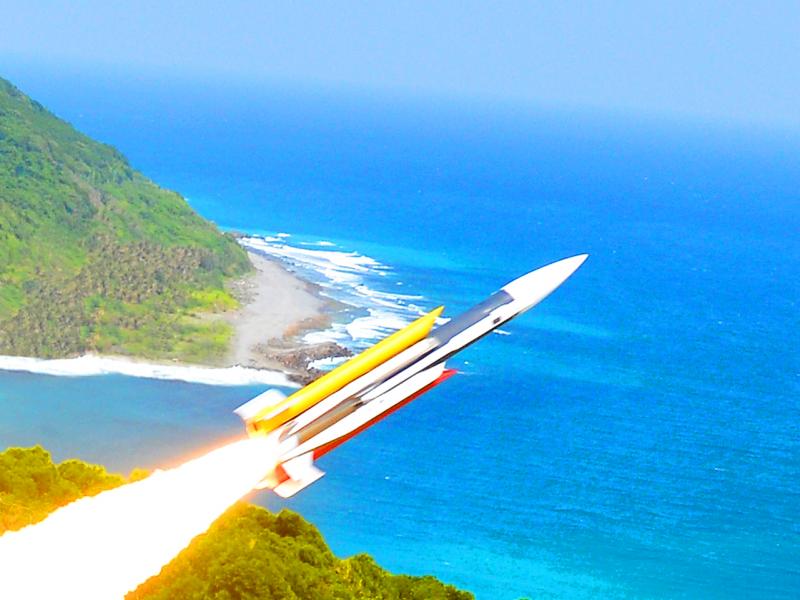The Ministry of National Defense (MND) has provided a timetable for its long-range missile programs in a report to the Legislative Yuan following the passage of a NT$237 billion (US$8.45 billion) budget in January.
The report follows a request by lawmakers for a timetable on implementing the Sea-Air Combat Power Improvement Plan, a five-year program that started earlier this year, a source said yesterday on condition of anonymity.
The Hsiung Feng III, a supersonic missile that can attack ships and ground-based targets up to a range of 400km, is to enter mass production next year, which would raise its annual capacity to 70 units from 20 now, the source said, citing the report.

Photo copied by Chen Hsien-yi, Taipei Times
The increase follows the construction of six new facilities, which the Chungshan Institute of Science and Technology is to complete in late June, the report said.
The Hsiung Sheng cruise missile, with an estimated range of 1,000km to 1,200km — enough to reach China — has been confirmed to be the same system formerly known as the Hsiung Feng IIE missile, the source said.
The combined annual production capacity of Hsiung Sheng and Hsiung Feng II missiles — which share assembly lines — would rise to 131 units from 81 units, the report said.
Basic and extended-range Hsiung Feng missiles are being deployed on Taiwan proper and outlying islands as a defense against the Chinese People’s Liberation Army Navy’s large warships, it added.
The Hai Chien II surface-to-air missile — which can be launched from the ground or a ship — would see its annual production rise to 150 units from 40 units, the report said.
The annual production capacity of Tien Kung III air defense missiles would also increase to 96 units from 48, while the Wan Chien air-to-ground cruise missiles and the Chien Hsiang loitering munition would reach 50 units and 48 units respectively, it said.
This should result in production of the Hsiung Sheng missile, the Wan Chien missile and the Chien Hsiang loitering munition being completed in 2024 or 2025, ahead of schedule, the report said.
The combat power improvement plan was intended for the acquisition of long-range cruise missiles, upgraded air defense systems and modern warships, government statements said at the time.

Taiwan is to commence mass production of the Tien Kung (天弓, “Sky Bow”) III, IV and V missiles by the second quarter of this year if the legislature approves the government’s NT$1.25 trillion (US$39.78 billion) special defense budget, an official said yesterday. Commenting on condition of anonymity, a defense official with knowledge of the matter said that the advanced systems are expected to provide crucial capabilities against ballistic and cruise missiles for the proposed “T-Dome,” an advanced, multi-layered air defense network. The Tien Kung III is an air defense missile with a maximum interception altitude of 35km. The Tien Kung IV and V

The disruption of 941 flights in and out of Taiwan due to China’s large-scale military exercises was no accident, but rather the result of a “quasi-blockade” used to simulate creating the air and sea routes needed for an amphibious landing, a military expert said. The disruptions occurred on Tuesday and lasted about 10 hours as China conducted live-fire drills in the Taiwan Strait. The Civil Aviation Administration (CAA) said the exercises affected 857 international flights and 84 domestic flights, affecting more than 100,000 travelers. Su Tzu-yun (蘇紫雲), a research fellow at the government-sponsored Institute for National Defense and Security Research, said the air

A strong continental cold air mass is to bring pollutants to Taiwan from tomorrow, the Ministry of Environment said today, as it issued an “orange” air quality alert for most of the country. All of Taiwan except for Hualien and Taitung counties is to be under an “orange” air quality alert tomorrow, indicating air quality that is unhealthy for sensitive groups. In China, areas from Shandong to Shanghai have been enveloped in haze since Saturday, the ministry said in a news release. Yesterday, hourly concentrations of PM2.5 in these areas ranged from 65 to 160 micrograms per cubic meter (mg/m³), and pollutants were

Taiwan lacks effective and cost-efficient armaments to intercept rockets, making the planned “T-Dome” interception system necessary, two experts said on Tuesday. The concerns were raised after China’s military fired two waves of rockets during live-fire drills around Taiwan on Tuesday, part of two-day exercises code-named “Justice Mission 2025.” The first wave involved 17 rockets launched at 9am from Pingtan in China’s Fujian Province, according to Lieutenant General Hsieh Jih-sheng (謝日升) of the Office of the Deputy Chief of the General Staff for Intelligence at the Ministry of National Defense. Those rockets landed 70 nautical miles (129.6km) northeast of Keelung without flying over Taiwan,